NPP Variability Associated with Natural and Anthropogenic Factors in the Tropic of Cancer Transect, China
Abstract
1. Introduction
2. Materials and Methods
2.1. Study Area
2.2. Datasets and Processing
2.3. Driving Factors
2.4. NPP Estimation and Validation
2.5. NPP Trend Analysis
2.6. Contributions of Climate Variability and Human Activities to NPP Change
2.7. Geographical Detector Analysis
3. Results
3.1. Validation of NPP Estimation
3.2. Spatial Patterns and Trends of NPP
3.2.1. Spatial Patterns of NPP
3.2.2. Temporal Trends in NPP
3.3. Relative Contributions of Climate Variability and Anthropogenic Activities to NPP Dynamics
3.3.1. Correlations between NPP and Climatic Factors
3.3.2. Contributions of Climate Variability and Anthropogenic Activities to NPP Variability
3.4. Influence of Natural and Anthropogenic Factors on NPP
3.4.1. Independent Effects of Different Factors on NPP
3.4.2. Interactive Effects of Factors on NPP
4. Discussion
4.1. Spatial Heterogeneity and Trends in NPP
4.2. Contribution of Climate Variability and Anthropogenic Activities to NPP
4.3. Influences of Natural and Anthropogenic Factors on Spatial Patterns and Changes of NPP
4.4. Limitations and Uncertainties in NPP Estimates
5. Conclusions
Author Contributions
Funding
Data Availability Statement
Conflicts of Interest
References
- Field, C.B.; Behrenfeld, M.J.; Randerson, J.T.; Falkowski, P. Primary Production of the Biosphere: Integrating Terrestrial and Oceanic Components. Science 1998, 281, 237–240. [Google Scholar] [CrossRef] [PubMed]
- Gao, Q.Z.; Li, Y.; Wan, Y.F.; Qin, X.B.; Jiang, C.; Wang, Z.; Liu, Y.H. Dynamics of Alpine Grassland NPP and Its Response to Climate Change in Northern Tibet. Clim. Chang. 2009, 97, 515–528. [Google Scholar] [CrossRef]
- Foley, J.A.; DeFries, R.; Asner, G.P.; Barford, C.; Bonan, G. Global Consequences of Land Use. Science 2005, 309, 570–574. [Google Scholar] [CrossRef]
- Stevens-Rumann, C.S.; Kemp, K.B.; Higuera, P.E.; Harvey, B.J.; Rother, M.T.; Donato, D.C.; Morgan, P.; Veblen, T.T. Evidence for Declining Forest Resilience to Wildfires under Climate Change. Ecol. Lett. 2018, 21, 243–252. [Google Scholar] [CrossRef] [PubMed]
- Cheng, F.C.; Zhang, H.; Fan, W.J.; Harris, B. Image Recognition Technology Based on Deep Learning. Wirel. Pers. Commun. 2018, 102, 1917–1933. [Google Scholar] [CrossRef]
- Pei, F.S.; Li, X.; Liu, X.P.; Lao, C.H.; Xia, G.R. Exploring the Response of Net Primary Productivity Variations to Urban Expansion and Climate Change: A Scenario Analysis for Guangdong Province in China. J. Environ. Manag. 2015, 150, 92–102. [Google Scholar] [CrossRef]
- Woodward, F.I. Climate and Plant Distribution; Cambridge University Press: Cambridge, UK, 1987. [Google Scholar]
- Fang, J.Y.; Chen, A.P.; Peng, C.H.; Zhao, S.; Ci, L. Changes in Forest Biomass Carbon Storage in China between 1949 and 1998. Science 2001, 292, 2320–2322. [Google Scholar] [CrossRef]
- Li, Y.L.; Zhang, P.X.; Wang, C.K.; Liu, Y.; Zhao, Q.G. Changes of Vegetation Net Primary Productivity and Its Driving Factors from 2000 to 2011 in Guangxi, China. Acta Ecol. Sin. 2014, 34, 5220–5228. [Google Scholar]
- Guo, B.; Zang, W.; Yang, F.; Han, B.; Chen, S.; Liu, Y.; Yang, X.; He, T.; Chen, X.; Liu, C.; et al. Spatial and Temporal Change Patterns of Net Primary Productivity and Its Response to Climate Change in the Qinghai-Tibet Plateau of China from 2000 to 2015. J. Arid Land 2020, 12, 1–17. [Google Scholar] [CrossRef]
- Whitlock, C.; Bartlein, P.J. Vegetation and Climate Change in Northwest America during the Past 125kyr. Nature 1997, 388, 57–60. [Google Scholar] [CrossRef]
- Nemani, R.R.; Keeling, C.D.; Hashimoto, H.; Jolly, W.M.; Piper, S.C.; Tucker, C.J.; Myneni, R.B.; Running, S.W. Climate-Driven Increases in Global Terrestrial Net Primary Production from 1982 to 1999. Science 2003, 300, 1560–1563. [Google Scholar] [CrossRef] [PubMed]
- Potter, C.; Klooster, S.; Genovese, V. Net Primary Production of Terrestrial Ecosystems from 2000 to 2009. Clim. Chang. 2012, 115, 365–378. [Google Scholar] [CrossRef]
- Zhu, W.Q.; Pan, Y.Z.; Yang, X.Q.; Song, G.B. Comprehensive Analysis of the Impact of Climatic Changes on Chinese Terrestrial Net Primary Productivity. Chin. Sci. Bull. 2007, 52, 3253–3260. [Google Scholar] [CrossRef]
- Liang, W.; Yang, Y.T.; Fan, D.M.; Guan, H.; Zhang, T.; Long, D.; Zhou, Y.; Bai, D. Analysis of Spatial and Temporal Patterns of Net Primary Production and Their Climate Controls in China from 1982 to 2010. Agric. For. Meteorol. 2015, 204, 22–36. [Google Scholar] [CrossRef]
- Yin, K.; Tian, Y.C.; Yuan, C.; Zhang, F.F.; Yuan, Q.Z.; Hua, L.Z. NPP Spatial and Temporal Pattern of Vegetation in Beijing and Its Factors Explanation Based CASA Model. Remote Sens. Land Resour. 2015, 27, 133–139. [Google Scholar]
- Gao, Q.Z.; Wan, Y.F.; Li, Y.; Guo, Y.Q.; Ganjurjav; Qin, X.B.; Jiang, C.; Wang, Z.; Wang, B.S. Effects of Topography and Human Activity on the Net Primary Productivity (NPP) of Alpine Grassland in Northern Tibet from 1981 to 2004. Int. J. Remote Sens. 2013, 34, 2057–2069. [Google Scholar] [CrossRef]
- Chen, X.F.; Chen, J.M.; An, S.Q.; Ju, W.M. Effects of Topography on Simulated Net Primary Productivity at Landscape Scale. J. Environ. Manag. 2007, 85, 585–596. [Google Scholar] [CrossRef] [PubMed]
- Guo, B.; Zang, W.Q.; Luo, W. Spatial-Temporal Shifts of Ecological Vulnerability of Karst Mountain Ecosystem-Impacts of Global Change and Anthropogenic Interference. Sci. Total Environ. 2020, 741, 140256. [Google Scholar] [CrossRef]
- Liang, L.; Zhao, S.; Qin, Z.; He, K.; Chen, C.; Luo, Y.; Zhou, X. Drought Change Trend Using MODIS TVDI and Its Relationship with Climate Factors in China from 2001 to 2010. J. Integr. Agric. 2014, 13, 1501–1508. [Google Scholar] [CrossRef]
- Gu, F.X.; Zhang, Y.D.; Huang, M.; Tao, B.; Liu, Z.J.; Hao, M.; Guo, R.; Guo, R. Climate-Driven Uncertainties in Modeling Terrestrial Ecosystem Net Primary Productivity in China. Agric. For. Meteorol. 2017, 246, 123–132. [Google Scholar] [CrossRef]
- Wen, Z.; Wu, S.; Chen, J.; Lü, M. NDVI Indicated Long-Term Interannual Changes in Vegetation Activities and Their Responses to Climatic and Anthropogenic Factors in the Three Gorges Reservoir Region, China. Sci. Total Environ. 2017, 574, 947–959. [Google Scholar] [CrossRef]
- Peng, J.; Shen, H.; Wu, W.; Liu, Y.; Wang, Y. Net Primary Productivity (NPP) Dynamics and Associated Urbanization Driving Forces in Metropolitan Areas: A Case Study in Beijing City, China. Landsc. Ecol. 2016, 31, 1077–1092. [Google Scholar] [CrossRef]
- Zhang, Y.; Zhang, C.; Wang, Z.Q.; Chen, Y.Z.; Gang, C.C.; An, R.; Li, J.L. Vegetation Dynamics and Its Driving Forces from Climate Change and Human Activities in the Three-River Source Region, China from 1982 to 2012. Sci. Total Environ. 2016, 563–564, 210–220. [Google Scholar] [CrossRef]
- Mao, D.H.; Wang, Z.M.; Wu, C.S.; Song, K.S.; Ren, C.Y. Examining Forest Net Primary Productivity Dynamics and Driving Forces in Northeastern China during 1982-2010. Chin. Geogr. Sci. 2014, 24, 631–646. [Google Scholar] [CrossRef]
- Jiang, C.; Wu, Z.F.; Cheng, J.; Yu, Q.; Rao, X.Q. Impacts of Urbanization on Net Primary Productivity in the Pearl River Delta, China. Int. J. Plant Prod. 2015, 9, 581–598. [Google Scholar]
- Qu, S.; Wang, L.C.; Lin, A.W.; Zhu, H.J.; Yuan, M.X. What Drives the Vegetation Restoration in Yangtze River Basin, China: Climate Change or Anthropogenic Factors? Ecol. Indic. 2018, 90, 438–450. [Google Scholar] [CrossRef]
- Teng, M.J.; Zeng, L.X.; Hu, W.J.; Wang, P.C.; Yan, Z.G.; He, W.; Zhang, Y.; Huang, Z.L.; Xiao, W.F. The Impacts of Climate Changes and Human Activities on Net Primary Productivity Vary across an Ecotone Zone in Northwest China. Sci. Total Environ. 2020, 714, 136691. [Google Scholar] [CrossRef]
- Liu, X.; Liang, X.; Li, X.; Xu, X.; Ou, J.; Chen, Y.; Li, S.; Wang, S.; Pei, F. A Future Land Use Simulation Model (FLUS) for Simulating Multiple Land Use Scenarios by Coupling Human and Natural Effects. Landsc. Urban Plan. 2017, 168, 94–116. [Google Scholar] [CrossRef]
- Wu, Y.Y.; Luo, Z.H.; Wu, Z.F. The Different Impacts of Climate Variability and Human Activities on NPP in the Guangdong–Hong Kong–Macao Greater Bay Area. Remote Sens. 2022, 14, 2929. [Google Scholar] [CrossRef]
- Wu, Y.Y.; Luo, Z.H.; Wu, Z.F. Net Primary Productivity Dynamics and Driving Forces in Guangzhou City, China. Appl. Ecol. Environ. Res. 2018, 16, 6667–6690. [Google Scholar] [CrossRef]
- Zhou, A.P.; Xiang, W.S.; Yao, Y.F.; Huang, F.Z.; LI, X.K. Analyzing Variation Characteristics of Vegetation Net Primary Productivity (NPP) in Guangxi. Guihaia 2014, 34, 622–628. [Google Scholar]
- Bhattacharya, R.; Roy, R.; Das, R. Diversity and Distribution of Local Birds beside the Tropic of Cancer. Int. J. Environ. Sci. 2013, 3, 1321–1329. [Google Scholar] [CrossRef]
- Holben, B.N. Characteristics of Maximum-Value Composite Images from Temporal AVHRR Data. Int. J. Remote Sens. 1986, 7, 1417–1434. [Google Scholar] [CrossRef]
- Gong, Z.; Zhao, S.; Gu, J. Correlation Analysis between Vegetation Coverage and Climate Drought Conditions in North China during 2001–2013. J. Geogr. Sci. 2017, 27, 143–160. [Google Scholar] [CrossRef]
- Zhang, X.; Liu, L.Y.; Wu, C.S.; Chen, X.D.; Gao, Y.; Xie, S.; Zhang, B. Development of a Global 30 m Impervious Surface Map Using Multisource and Multitemporal Remote Sensing Datasets with the Google Earth Engine Platform. Earth Syst. Sci. Data 2020, 12, 1625–1648. [Google Scholar] [CrossRef]
- Zhang, X.; Liu, L.Y.; Chen, X.D.; Gao, Y.; Xie, S.; Mi, J. GLC_FCS30: Global Land-Cover Product with Fine Classification System at 30 m Using Time-Series Landsat Imagery. Earth Syst. Sci. Data 2021, 13, 2753–2776. [Google Scholar] [CrossRef]
- Zhang, L.P. Characteristics of CO2 Flux in a Chinses Fire Plantations Ecosystem in Huitong Country, Hunan Province. Masters’s Thesis, Central South University of Forestry & Technology, Changsha, China, 2010. [Google Scholar]
- Tan, Z.H.; Zhang, Y.P.; Schaefer, D.; Yu, G.R.; Liang, N.; Song, Q.H. An Old-Growth Subtropical Asian Evergreen Forest as a Large Carbon Sink. Atmos. Environ. 2011, 45, 1548–1554. [Google Scholar] [CrossRef]
- Zhao, Z.H. A Study on Carbon Flux between Chinese Fire Plantations and Atmosphere in Subtropical Belts. Ph.D. Thesis, Central South University of Forestry & Technology, Changsha, China, 2011. [Google Scholar]
- Sun, C.J. Study of CO2 Flux above Urban Green Space in Pearl River Delta. Master’s Thesis, Nanjing University of Information Science & Technology, Nanjing, China, 2012. [Google Scholar]
- Yu, G.R.; Zhu, X.J.; Fu, Y.L.; He, H.L.; Wang, Q.F.; Wen, X.-F.; Li, X.-R.; Zhang, L.M.; Zhang, L.; Su, W.; et al. Spatial Patterns and Climate Drivers of Carbon Fluxes in Terrestrial Ecosystems of China. Glob. Chang. Biol. 2013, 19, 798–810. [Google Scholar] [CrossRef]
- Zhou, W.S.; Zhang, C.T.; Zhou, Z.P. Correction of the Relationship between Altitude and Latitude of Vegetation Distribution. Sci. Sin. Vitae 2021, 51, 334–345. [Google Scholar] [CrossRef]
- Wu, Y.Y.; Wu, Z.F.; Liu, X.N. Dynamic Changes of Net Primary Productivity and Associated Urban Growth Driving Forces in Guangzhou City, China. Environ. Manag. 2020, 65, 758–773. [Google Scholar] [CrossRef]
- Potter, C.S.; Randerson, J.T.; Field, C.B.; Matson, P.A.; Vitousek, P.M.; Mooney, H.A.; Klooster, S.A. Terrestrial Ecosystem Production: A Process Model Based on Global Satellite and Surface Data. Glob. Biogeochem. Cycles 1993, 7, 811–841. [Google Scholar] [CrossRef]
- Field, C.B.; Randerson, J.T.; Malmström, C.M. Global Net Primary Production: Combining Ecology and Remote Sensing. Remote Sens. Environ. 1995, 51, 74–88. [Google Scholar] [CrossRef]
- Piao, S.L.; Fang, J.Y.; Zhou, L.M.; Zhu, B.; Tan, K.; Tao, S. Changes in Vegetation Net Primary Productivity from 1982 to 1999 in China. Glob. Biogeochem. Cycles 2005, 19, 1605–1622. [Google Scholar] [CrossRef]
- Ruimy, A.; Saugier, B.; Dedieu, G. Methodology for the Estimation of Terrestrial Net Primary Production from Remotely Sensed Data. J. Geophys. Res. 1994, 99, 5263. [Google Scholar] [CrossRef]
- Prince, S.D. A Model of Regional Primary Production for Use with Coarse Resolution Satellite Data. Int. J. Remote Sens. 1991, 12, 1313–1330. [Google Scholar] [CrossRef]
- Zhu, W.Q.; Pan, Y.Z.; He, H.; Yu, D.Y.; Hu, H.B. Simulation of Maximum Light Use Efficiency for Some Typical Vegetation Types in China. Chin. Sci. Bull. 2006, 51, 457–463. [Google Scholar] [CrossRef]
- Lin, P.L.; Brunsell, N. Assessing Regional Climate and Local Landcover Impacts on Vegetation with Remote Sensing. Remote Sens. 2013, 5, 4347–4369. [Google Scholar] [CrossRef]
- Yu, D.Y.; Shi, P.J.; Shao, H.B.; Zhu, W.Q.; Pan, Y.Z. Modelling Net Primary Productivity of Terrestrial Ecosystems in East Asia Based on an Improved CASA Ecosystem Model. Int. J. Remote Sens. 2009, 30, 4851–4866. [Google Scholar] [CrossRef]
- Gill, R.A.; Kelly, R.H.; Parton, W.J.; Day, K.A.; Jackson, R.B.; Morgan, J.A.; Scurlock, J.M.O.; Tieszen, L.L.; Castle, J.V.; Ojima, D.S. Using Simple Environmental Variables to Estimate Below-Ground Productivity in Grasslands. Glob. Ecol. Biogeogr 2002, 11, 79–86. [Google Scholar] [CrossRef]
- Wang, J.; Wang, K.L.; Zhang, M.Y.; Zhang, C.H. Impacts of Climate Change and Human Activities on Vegetation Cover in Hilly Southern China. Ecol. Eng. 2015, 81, 451–461. [Google Scholar] [CrossRef]
- Neeti, N.; Eastman, J.R. A Contextual Mann-Kendall Approach for the Assessment of Trend Significance in Image Time Series. Trans. GIS 2011, 15, 599–611. [Google Scholar] [CrossRef]
- Kendall, M.G. Rank Correlation Methods; Griffin: London, UK, 1975. [Google Scholar]
- McCuen, R.H. A Sensitivity and Error Analysis of Procedures Used for Estimating Evaporation. J. Am. Water Resour. Assoc. 1974, 10, 486–497. [Google Scholar] [CrossRef]
- Ge, W.Y.; Deng, L.Q.; Wang, F.; Han, J.Q. Quantifying the Contributions of Human Activities and Climate Change to Vegetation Net Primary Productivity Dynamics in China from 2001 to 2016. Sci. Total Environ. 2021, 773, 145648. [Google Scholar] [CrossRef] [PubMed]
- Tong, X.W.; Wang, K.L.; Yue, Y.M.; Brandt, M.; Liu, B.; Zhang, C.H.; Liao, C.J.; Fensholt, R. Quantifying the Effectiveness of Ecological Restoration Projects on Long-Term Vegetation Dynamics in the Karst Regions of Southwest China. Int. J. Appl. Earth Obs. Geoinf. 2017, 54, 105–113. [Google Scholar] [CrossRef]
- Luedeling, E.; Gassner, A. Partial Least Squares Regression for Analyzing Walnut Phenology in California. Agric. For. Meteorol. 2012, 158–159, 43–52. [Google Scholar] [CrossRef]
- Wang, J.F.; Xu, C.D. Geodetector: Principle and Prospective. Dili Xuebao/Acta Geogr. Sin. 2017, 72, 116–134. [Google Scholar] [CrossRef]
- Wang, J.F.; Li, X.H.; Christakos, G.; Liao, Y.L.; Zhang, T.; Gu, X.; Zheng, X.Y. Geographical Detectors-Based Health Risk Assessment and Its Application in the Neural Tube Defects Study of the Heshun Region, China. Int. J. Geogr. Inf. Sci. 2010, 24, 107–127. [Google Scholar] [CrossRef]
- Jiang, C.; Wu, Z.F.; Jiong, C.; Qian, L.X. Analyzing the Effects of Land Cover Change on Vegetation Net Primary Productivity in Guangdong Province. J. Nat. Resour. 2016, 31, 961–972. [Google Scholar]
- Guan, X.B.; Shen, H.F.; Member, S.; Li, X.H.; Gan, W.X. Climate Control on Net Primary Productivity in the Complicated Mountainous Area: A Case Study of Yunnan, China. IEEE J. Sel. Top. Appl. Earth Obs. Remote Sens. 2018, 11, 4637–4648. [Google Scholar] [CrossRef]
- Wang, S.Y.; Hu, W.Y. Remote Sensing Estimation of Net Primary Productivity of Vegetation (NPP) in Yunnan Province Based on CASA Model. Yunnan Geogr. Environ. Res. 2019, 31, 71–78. [Google Scholar]
- Chen, W.; Bai, S.; Zhao, H.M.; Han, X.R.; Li, L.H. Spatiotemporal Analysis and Potential Impact Factors of Vegetation Variation in the Karst Region of Southwest China. Environ. Sci. Pollut. Res. 2021, 28, 61258–61273. [Google Scholar] [CrossRef] [PubMed]
- Zhang, Y.L.; Song, C.H.; Zhang, K.R.; Cheng, X.L.; Zhang, Q.F. Spatial-Temporal Variability of Terrestrial Vegetation Productivity in the Yangtze River Basin during 2000–2009. J. Plant Ecol. 2014, 7, 10–23. [Google Scholar] [CrossRef]
- Tong, X.W.; Wang, K.L.; Brandt, M.; Yue, Y.M.; Liao, C.J.; Fensholt, R. Assessing Future Vegetation Trends and Restoration Prospects in the Karst Regions of Southwest China. Remote Sens. 2016, 8, 357. [Google Scholar] [CrossRef]
- Ma, J.; Weng, B.; Bi, W.X.; Xu, D.; Xu, T.; Yan, D.M. Impact of Climate Change on the Growth of Typical Crops in Karst Areas: A Case Study of Guizhou Province. Adv. Meteorol. 2019, 2019, 1401402. [Google Scholar] [CrossRef]
- Qu, S.; Wang, L.C.; Lin, A.W.; Yu, D.Q.; Yuan, M.X.; Li, C.A. Distinguishing the Impacts of Climate Change and Anthropogenic Factors on Vegetation Dynamics in the Yangtze River Basin, China. Ecol. Indic. 2020, 108, 105724. [Google Scholar] [CrossRef]
- Liu, S.; Wang, B.; Zhang, J.; Cai, D.; Tian, G.; Zhang, G. Predicting the Seasonal NDVI Change by GIS Geostatistical Analyst and Study on Driver Factors of NDVI Change in Hainan Island, China. J. Geosci. Environ. Prot. 2016, 04, 92–100. [Google Scholar] [CrossRef]
- Piao, S.L.; Fang, J.Y.; Chen, A.P. Seasonal Dynamics of Terrestrial Net Primary Production in Response to Climate Changes in China. Acta Bot. Sin. 2003, 45, 269–275. [Google Scholar]
- Zhang, Y.L.; Song, C.H.; Zhang, K.R.; Cheng, X.L.; Band, L.E.; Zhang, Q.F. Effects of Land Use/Land Cover and Climate Changes on Terrestrial Net Primary Productivity in the Yangtze River Basin, China, from 2001 to 2010. J. Geophys. Res. Biogeosci. 2014, 119, 1092–1109. [Google Scholar] [CrossRef]
- Zhang, Y. A Time-Series Approach to Detect Urbanized Areas Using Biophysical Indicators and Landsat Satellite Imagery. IEEE J. Sel. Top. Appl. Earth Obs. Remote Sens. 2021, 14, 9210–9222. [Google Scholar] [CrossRef]
- Zhao, S.; Wu, X.Q.; Zhou, J.X.; Pereira, P. Spatiotemporal Tradeoffs and Synergies in Vegetation Vitality and Poverty Transition in Rocky Desertification Area. Sci. Total Environ. 2021, 752, 141770. [Google Scholar] [CrossRef]
- Wen, X.D.; Luo, Z.H.; Fu, L.G. Effects of Climate and Land Use Change on NPP in Guangdong- Hong Kong-Macao Greater Bay Area. Guangxi Sci. 2021, 28, 290–300. (In Chinese) [Google Scholar]
- Ren, Y.M.; Zhou, T.G.; Li, H.Z. Research on the Urban Ecological Environment Pattern in the Main Urban Area of Chongqing Based on Remote Sensing and POI Data. Prog. Geophys. 2021, 36, 766–778. [Google Scholar]
- Chen, Y.Z.; Chen, L.Y.; Cheng, Y.; Ju, W.M.; Chen, H.Y.H.; Ruan, H.H. Afforestation Promotes the Enhancement of Forest LAI and NPP in China. For. Ecol. Manag. 2020, 462, 117990. [Google Scholar] [CrossRef]
- Zhang, M.Y.; Wang, K.L.; Liu, H.Y.; Wang, J.; Yue, Y.M. Impacts of Ecological Restoration on Vegetation Carbon Storage in the Typical Karst Region of Northwest Guangxi, China. Chin. J. Ecol. 2014, 33, 2288–2295. [Google Scholar] [CrossRef]
- Zhang, X.M.; Yue, Y.M.; Tong, X.W.; Wang, K.; Qi, X.K.; Deng, C.X.; Brandt, M. Eco-Engineering Controls Vegetation Trends in Southwest China Karst. Sci. Total Environ. 2021, 770, 145160. [Google Scholar] [CrossRef]
- Chen, S.T.; Guo, B.; Zhang, R.; Zang, W.Q.; Wei, C.X.; Wu, H.W.; Yang, X.; Zhen, X.Y.; Li, X.; Zhang, D.F.; et al. Quantitatively Determine the Dominant Driving Factors of the Spatial—Temporal Changes of Vegetation NPP in the Hengduan Mountain Area during 2000–2015. J. Mt. Sci. 2021, 18, 427–445. [Google Scholar] [CrossRef]
- Yin, L.; Dai, E.; Zheng, D.; Wang, Y.; Ma, L.; Tong, M. What Drives the Vegetation Dynamics in the Hengduan Mountain Region, Southwest China: Climate Change or Human Activity? Ecol. Indic. 2020, 112, 106013. [Google Scholar] [CrossRef]
- Zhao, M.; Running, S.W. Drought-Induced Reduction in Global Terrestrial Net Primary Production from 2000 through 2009. Science 2010, 329, 940–943. [Google Scholar] [CrossRef]
- Garbulsky, M.F.; Peñuelas, J.; Papale, D.; Ardö, J.; Goulden, M.L.; Kiely, G.; Richardson, A.D.; Rotenberg, E.; Veenendaal, E.M.; Filella, I. Patterns and Controls of the Variability of Radiation Use Efficiency and Primary Productivity across Terrestrial Ecosystems. Glob. Ecol. Biogeogr. 2010, 19, 253–267. [Google Scholar] [CrossRef]
- Chen, T.; Tang, G.; Yuan, Y.; Guo, H.; Xu, Z.; Jiang, G.; Chen, X. Unraveling the Relative Impacts of Climate Change and Human Activities on Grassland Productivity in Central Asia over Last Three Decades. Sci. Total Environ. 2020, 743, 140649. [Google Scholar] [CrossRef]
- Jiang, H.; Xu, X.; Guan, M.; Wang, L.; Huang, Y.; Jiang, Y. Determining the Contributions of Climate Change and Human Activities to Vegetation Dynamics in Agro-Pastural Transitional Zone of Northern China from 2000 to 2015. Sci. Total Environ. 2020, 718, 134871. [Google Scholar] [CrossRef] [PubMed]
- Zhao, F.; Zhang, J.Y.; Liu, S.Y.; Wang, Z.Y.; Wang, L.H.; Gu, H.T.; Li, W.L. Assessing the Dividing Line between Warm Temperate and Subtropical Zones Based on the Zonality Discussion on Multi-Dimensional Response of Net Primary Productivity to Climate Change in the Qinling-Daba Mountains. Acta Ecol. Sin. 2021, 41, 57–68. [Google Scholar]
- Sui, X.H.; Zhou, G.S.; Zhuang, Q.L. Sensitivity of Carbon Budget to Historical Climate Variability and Atmospheric CO2 Concentration in Temperate Grassland Ecosystems in China. Clim. Chang. 2013, 117, 259–272. [Google Scholar] [CrossRef]
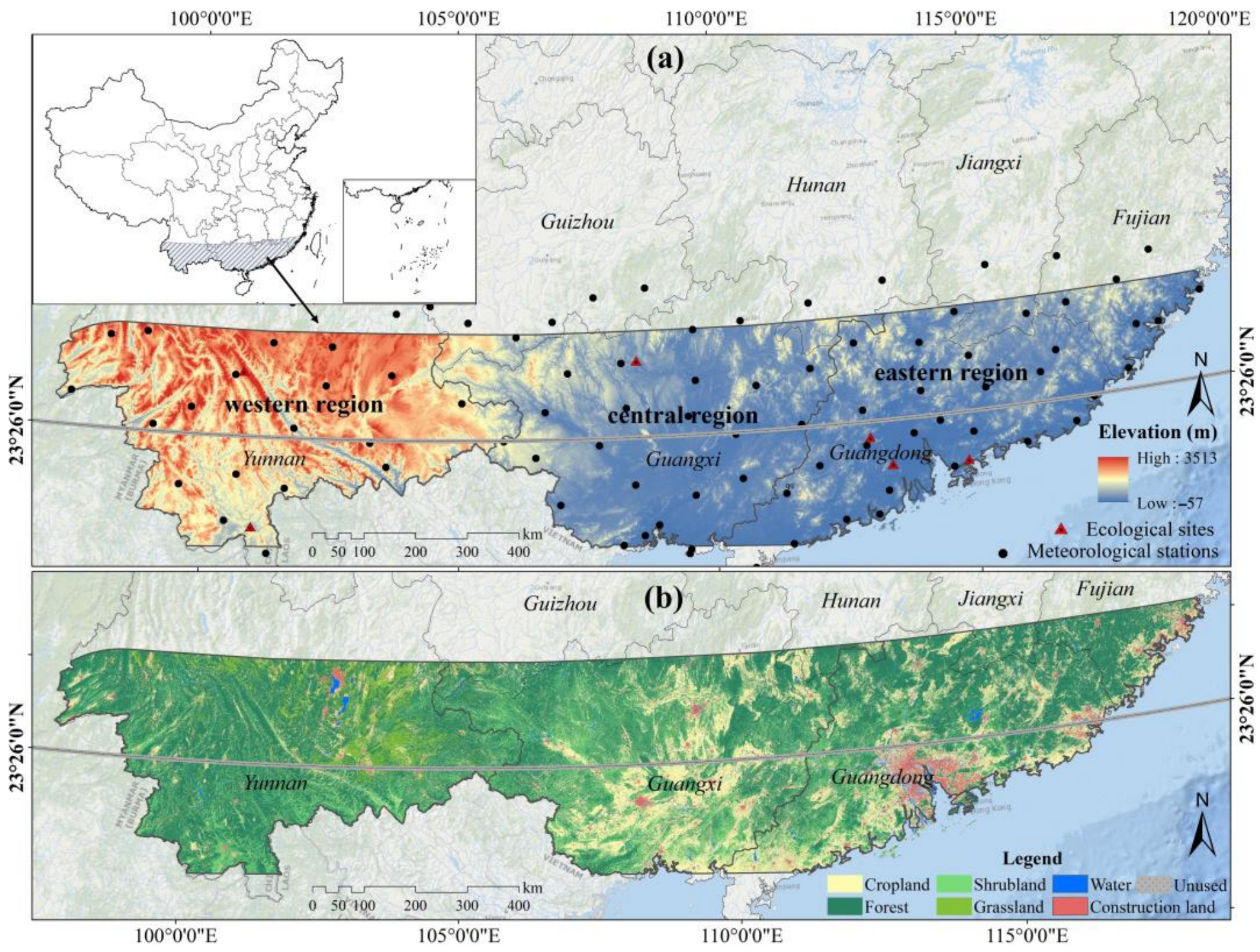
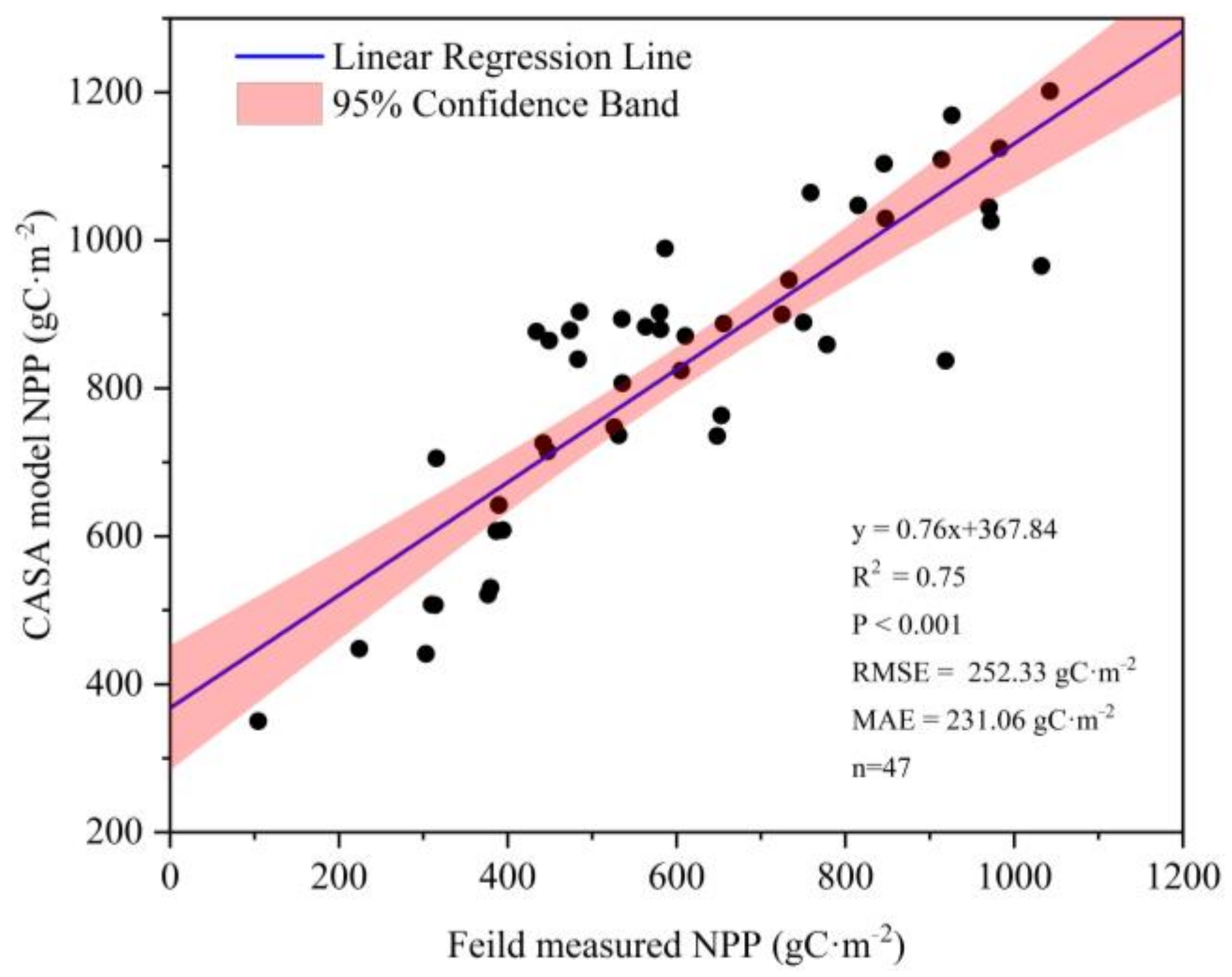

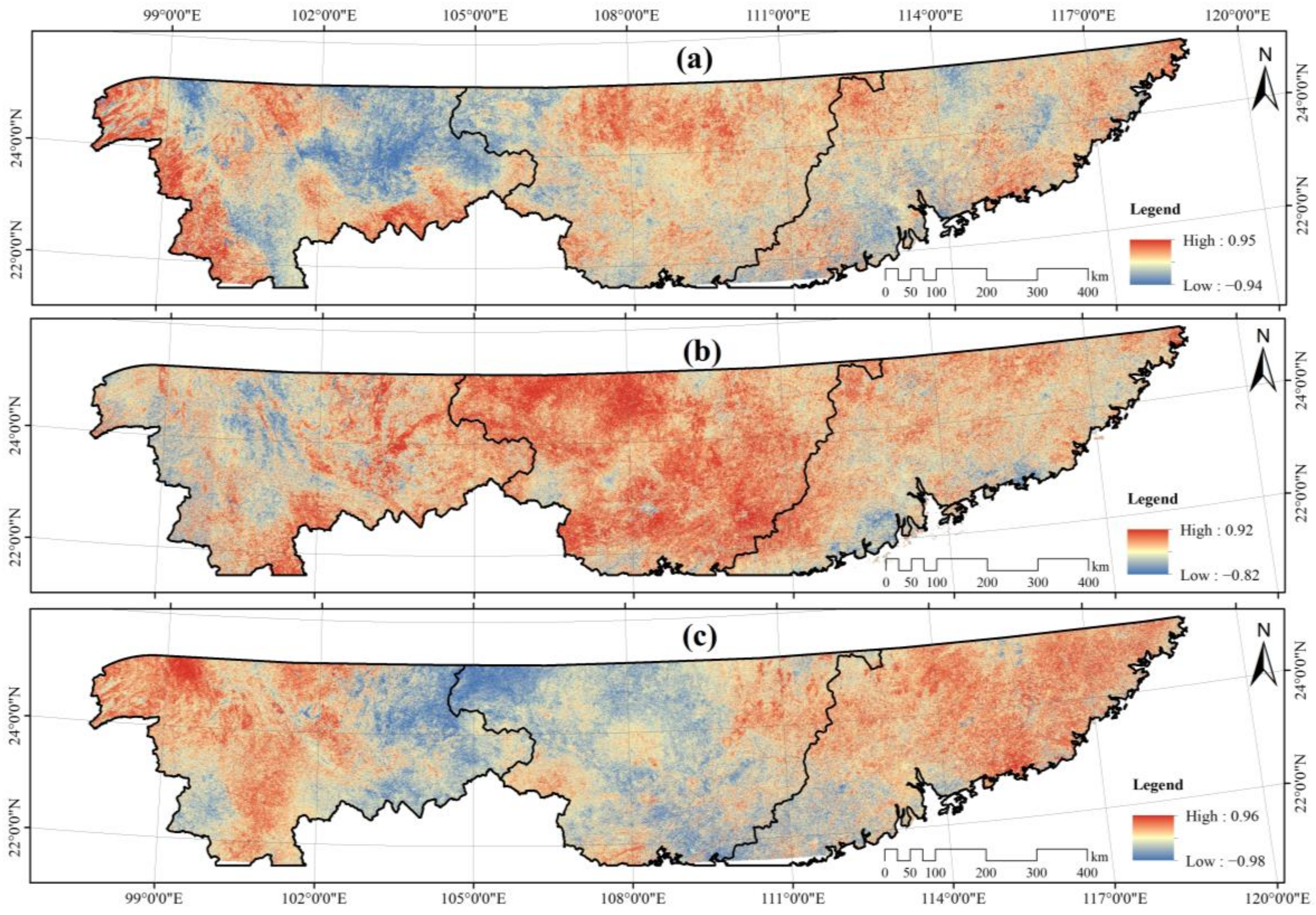


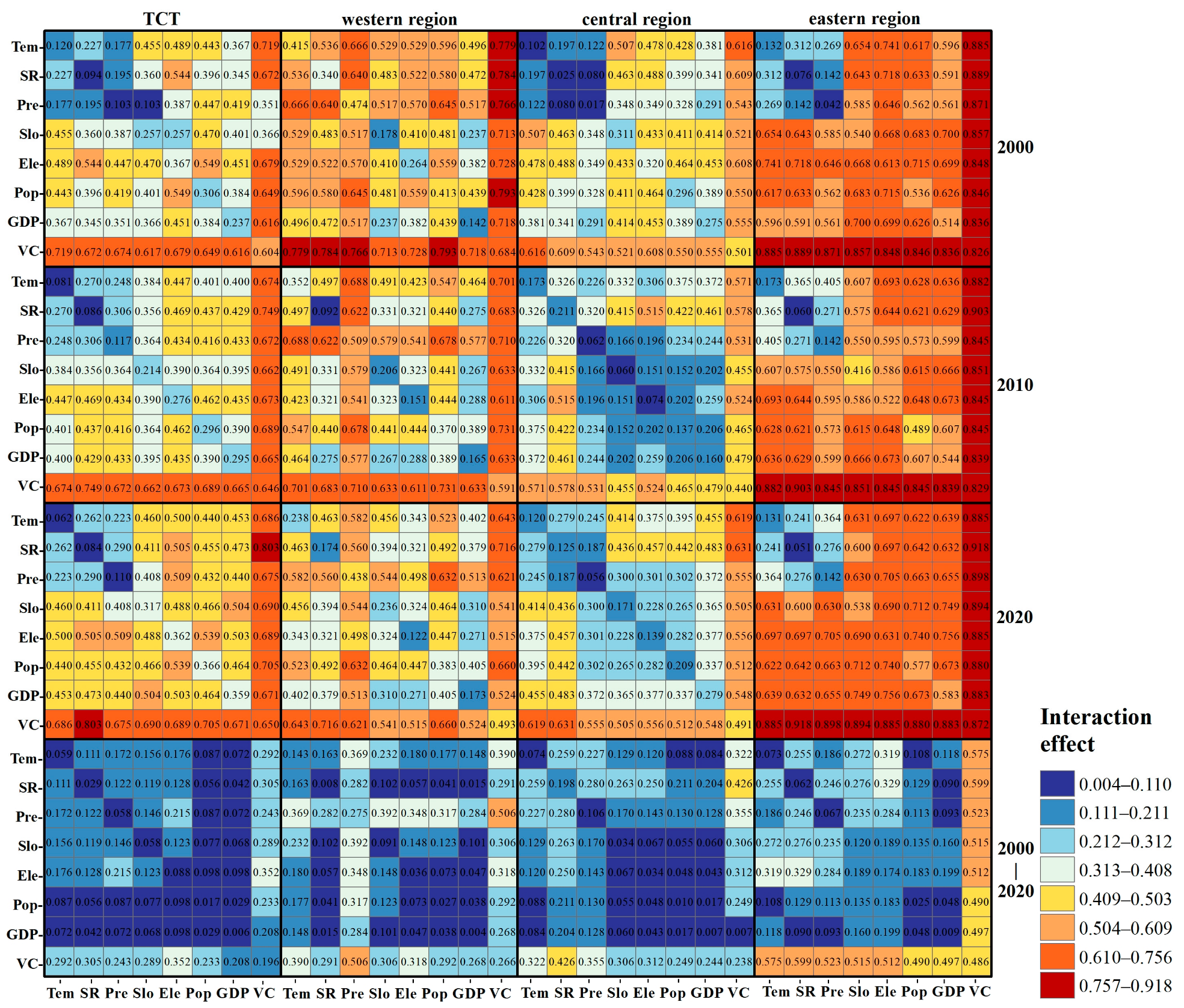

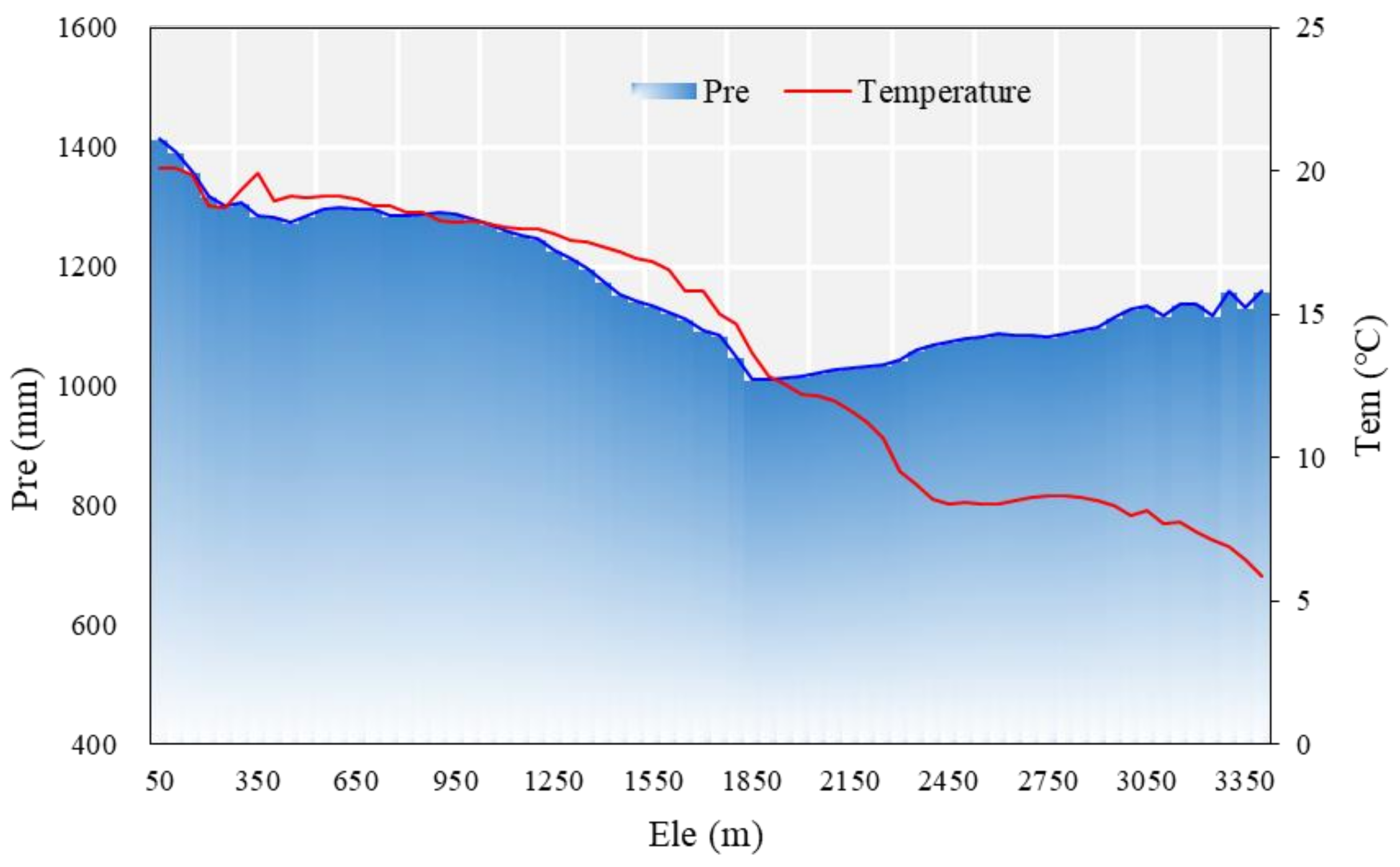
| Factors | Indexes | Meanings | Abbreviation | Representative Years/Period |
|---|---|---|---|---|
| Natural factors | Temperature | climate variables | Tem | 2000, 2010, 2020/2000–2020 |
| Precipitation | Pre | |||
| Solar radiation | SR | |||
| Elevation | Topographical factors | Ele | — | |
| Slope | Slo | — | ||
| Anthropogenic factors | Population density | Population distribution | Pop | 2000, 2010, 2020/2000–2020 |
| GDP | Regional economic situation and development level | GDP | ||
| Vegetation coverage | Status and richness of vegetation | VC |
| Year/Period | Study Area and Subregions | Tem | Pre | SR | Ele | Slo | Pop | GDP | VC |
|---|---|---|---|---|---|---|---|---|---|
| 2000 | TCT | 0.120 | 0.094 | 0.103 | 0.257 | 0.367 | 0.306 | 0.237 | 0.604 |
| western region | 0.415 | 0.340 | 0.474 | 0.178 | 0.264 | 0.413 | 0.142 | 0.684 | |
| central region | 0.102 | 0.025 | 0.017 | 0.311 | 0.320 | 0.296 | 0.275 | 0.501 | |
| eastern region | 0.132 | 0.076 | 0.042 | 0.540 | 0.613 | 0.536 | 0.514 | 0.826 | |
| 2010 | TCT | 0.081 | 0.086 | 0.117 | 0.214 | 0.276 | 0.296 | 0.295 | 0.646 |
| western region | 0.352 | 0.092 | 0.509 | 0.206 | 0.151 | 0.370 | 0.165 | 0.591 | |
| central region | 0.173 | 0.211 | 0.062 | 0.060 | 0.074 | 0.137 | 0.160 | 0.440 | |
| eastern region | 0.173 | 0.060 | 0.142 | 0.416 | 0.522 | 0.489 | 0.544 | 0.829 | |
| 2020 | TCT | 0.062 | 0.084 | 0.110 | 0.317 | 0.362 | 0.366 | 0.359 | 0.650 |
| western region | 0.238 | 0.174 | 0.438 | 0.236 | 0.122 | 0.383 | 0.173 | 0.493 | |
| central region | 0.120 | 0.125 | 0.056 | 0.171 | 0.139 | 0.209 | 0.279 | 0.491 | |
| eastern region | 0.131 | 0.051 | 0.142 | 0.538 | 0.631 | 0.577 | 0.583 | 0.872 | |
| NPP change trend from 2000 to 2020 | TCT | 0.059 | 0.029 | 0.058 | 0.058 | 0.088 | 0.017 | 0.006 | 0.196 |
| western region | 0.143 | 0.008 | 0.275 | 0.091 | 0.036 | 0.027 | 0.004 | 0.266 | |
| central region | 0.074 | 0.198 | 0.106 | 0.034 | 0.034 | 0.010 | 0.007 | 0.238 | |
| eastern region | 0.073 | 0.062 | 0.067 | 0.120 | 0.174 | 0.025 | 0.009 | 0.486 |
Disclaimer/Publisher’s Note: The statements, opinions and data contained in all publications are solely those of the individual author(s) and contributor(s) and not of MDPI and/or the editor(s). MDPI and/or the editor(s) disclaim responsibility for any injury to people or property resulting from any ideas, methods, instructions or products referred to in the content. |
© 2023 by the authors. Licensee MDPI, Basel, Switzerland. This article is an open access article distributed under the terms and conditions of the Creative Commons Attribution (CC BY) license (https://creativecommons.org/licenses/by/4.0/).
Share and Cite
Wu, Y.; Wu, Z. NPP Variability Associated with Natural and Anthropogenic Factors in the Tropic of Cancer Transect, China. Remote Sens. 2023, 15, 1091. https://doi.org/10.3390/rs15041091
Wu Y, Wu Z. NPP Variability Associated with Natural and Anthropogenic Factors in the Tropic of Cancer Transect, China. Remote Sensing. 2023; 15(4):1091. https://doi.org/10.3390/rs15041091
Chicago/Turabian StyleWu, Yanyan, and Zhifeng Wu. 2023. "NPP Variability Associated with Natural and Anthropogenic Factors in the Tropic of Cancer Transect, China" Remote Sensing 15, no. 4: 1091. https://doi.org/10.3390/rs15041091
APA StyleWu, Y., & Wu, Z. (2023). NPP Variability Associated with Natural and Anthropogenic Factors in the Tropic of Cancer Transect, China. Remote Sensing, 15(4), 1091. https://doi.org/10.3390/rs15041091







